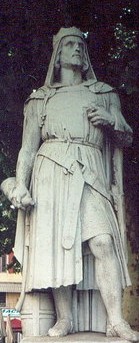Raimbaut II, Count Of Orange on:
[Wikipedia]
[Google]
[Amazon]
 Raimbaut II, Count of Orange (in
Raimbaut II, Count of Orange (in
 Raimbaut II, Count of Orange (in
Raimbaut II, Count of Orange (in Latin
Latin (, or , ) is a classical language belonging to the Italic branch of the Indo-European languages. Latin was originally a dialect spoken in the lower Tiber area (then known as Latium) around present-day Rome, but through the power ...
''Raimboldus comes de Oringis'') was the elder son of and of his first wife Gilberte.
Biography
Raimbaut's date of birth is not known (possibly around 1066 inOrange
Orange most often refers to:
*Orange (fruit), the fruit of the tree species '' Citrus'' × ''sinensis''
** Orange blossom, its fragrant flower
* Orange (colour), from the color of an orange, occurs between red and yellow in the visible spectrum ...
). According to two sources, Albert of Aix Albert of Aix(-la-Chapelle) or Albert of Aachen; la, Albericus Aquensis; ''fl.'' c. 1100) was a historian of the First Crusade and the early Kingdom of Jerusalem. He was born during the later part of the 11th century, and afterwards became canon ( ...
and William of Tyre
William of Tyre ( la, Willelmus Tyrensis; 113029 September 1186) was a medieval prelate and chronicler. As archbishop of Tyre, he is sometimes known as William II to distinguish him from his predecessor, William I, the Englishman, a forme ...
(neither of them eyewitnesses), he joined the First Crusade
The First Crusade (1096–1099) was the first of a series of religious wars, or Crusades, initiated, supported and at times directed by the Latin Church in the medieval period. The objective was the recovery of the Holy Land from Islamic ...
in the army of Raymond of Saint-Gilles
The army of Raymond of Saint-Gilles was one of the first to be formed after Pope Urban II called for the First Crusade. Raymond formed a Provençal army and left his County of Toulouse in October 1096, traveling over the land route. He was the ...
, presumably setting out in 1096; his name is linked with those of Adhemar of Le Puy
Adhemar (also known as Adémar, Aimar, or Aelarz) de Monteil (died 1 August 1098) was one of the principal figures of the First Crusade and was bishop of Puy-en-Velay from before 1087. He was the chosen representative of Pope Urban II for the ...
and Robert II of Flanders
Robert II, Count of Flanders (c. 1065 – 5 October 1111) was Count of Flanders from 1093 to 1111. He became known as Robert of Jerusalem (''Robertus Hierosolimitanus'') or Robert the Crusader after his exploits in the First Crusade.
Early li ...
, and he is said to have been present at the siege of Antioch
The siege of Antioch took place during the First Crusade in 1097 and 1098, on the crusaders' way to Jerusalem through Syria. Two sieges took place in succession. The first siege, by the crusaders against the city held by the Seljuk Empire, las ...
in 1098. He remained in Palestine
__NOTOC__
Palestine may refer to:
* State of Palestine, a state in Western Asia
* Palestine (region), a geographic region in Western Asia
* Palestinian territories, territories occupied by Israel since 1967, namely the West Bank (including East J ...
and died there, probably in 1121.
He married, but his wife's name is not known. No sons survived him. His daughter, Tiburge, Countess of Orange Tiburge of Orange (died 1150), was a suo jure ruling countess regnant of Orange from 1115 to 1150. Jacques de Font-Réaulx, Le testament de Tiburge d'Orange et la cristallisation de la principauté, p. 41-58, dans Provence historique, tome 6, Hors s ...
, in her father's prolonged absence, was being named "countess of Orange
Orange most often refers to:
*Orange (fruit), the fruit of the tree species '' Citrus'' × ''sinensis''
** Orange blossom, its fragrant flower
* Orange (colour), from the color of an orange, occurs between red and yellow in the visible spectrum ...
" as early as 1115. She married William of Aumelas William of Aumelas (or Omelas) was the second son of William V of Montpellier and of Ermessende, daughter of count Peter of Melgueil. The lordship of Aumelas (the Aumeladez) was detached from the territories of Montpellier to create a property for ...
, second son of William VI of Montpellier
William VI or Guillem VI (died 1161) was the eldest son of William V and his wife Ermessende, daughter of Count . William succeeded his father in the lordship of Montpellier in 1121, while still a minor, under his mother's guardianship. He suppres ...
; she was still alive in 1136. Their son (Raimbaut's only grandson) was the troubadour
A troubadour (, ; oc, trobador ) was a composer and performer of Old Occitan lyric poetry during the High Middle Ages (1100–1350). Since the word ''troubadour'' is etymologically masculine, a female troubadour is usually called a '' trobai ...
Raimbaut of Orange
Raimbaut of Orange (c. 1147 – 1173) or, in his native Old Provençal, Raimbaut d'Aurenga, was the lord of Orange and Aumelas. His properties included the towns of Frontignan and Mireval. He was the only son of William of Aumelas and of Ti ...
, and he inherited the territories of Aumelas
Aumelas (; Languedocien: ''Aumelaç'') is a commune in the Hérault department in southern France.
Population
See also
*Communes of the Hérault department
The following is a list of the 342 communes of the Hérault department of Fra ...
and Orange.
A statue of Raimbaut, count of Orange, was erected in the main square at Orange in 1846.
{{DEFAULTSORT:Raimbaut, count of Orange
11th-century births
1121 deaths
People from Orange, Vaucluse
Counts of Orange
Christians of the First Crusade